#Broiled Mackerell
Text
Japan's top-selling conveyor belt sushi chain Sushiro (スシロー) opened its first Southeast Asia outlet in Singapore on the Aug 19, 2019. I have wanted to visit it but somehow I have been putting it off due to it not being near where I am staying, that is until their Causeway Point branch opened.

I started off with three red plates (S$2.20++) and a gold plate (S$3.80++). The Broiled Mackerel Oshizushi with Mentai is topped with a thick piece of fish brushed with savoury sweet sauce. A refreshing shiso (perilla) leaf sits between the fish and rice. Hidden within the rice are seasoned pollack roe (mentaiko) which imparted the briny umami flavours.

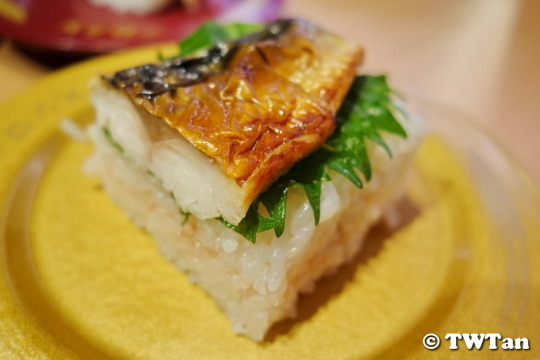

Next up, Spear Squid with Ponzu Jelly has two whole squids sitting atop their rice ball, topped with jellies and scallions. I read that the translucent squids are allowed to age for about a day to let the flesh turn white and acquire a sweet flavour. The ponzu jellies offered a lovely balanced sweet, sour and salty flavour to the otherwise plain mollusk.

When I ordered the Salmon with Basil Cheese, I was kind of skeptical on how this combination would work out. Popped the sushi into the mouth and I was pleasantly surprised by how good it tasted. The fish, cheese sauce, finely chopped basil leaves and the searing worked to bring out the best in flavours.

The Swordfish Sushi is plain looking after the all the colourful toppings that came before it. But it does make up with sweet and firm flesh, not forgetting to mention the tiny dollop of wasabi hidden underneath it.
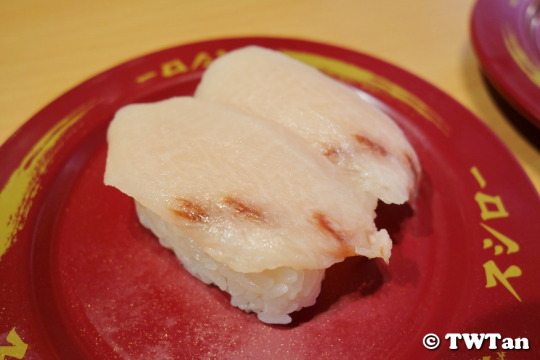
#Sushiro#スシロー#Japanese#Conveyor Belt Sushi#Restaurant#Causeway Point#Broiled Mackerell#Oshizushi#Mentaiko#Seasoned Pollack Roe#Spear Squid#Ponzu Jelly#Salmon#Basil#Cheese#Seared#Aburi#Swordfish#Fish#Seafood#Sushi#White Rice#Food#Buffetlicious
26 notes
·
View notes
Photo

Welcome to Abenaqui Club House, may I recommend the Broiled Salt Mackerel? http://menus.nypl.org/menus/22556
3 notes
·
View notes
Text
feeling creative in the kitchen again so here's some food dreams i have for the foreseeable future:
i made a rice bowl for breakfast/lunch (honestly i usually just combine these meals together lol) and along with rice in my rice cooker i put a TON of ginger, scallions, soy sauce, mirin, fish sauce, + a drizzle of sesame oil 2 flavor my rice as well as an egg to soft boil it, i ate this with fishwife mackerel and 1/2 an avocado
miso glazed cod broiled til it's golden !!!! just craving that delicate flakiness that cod provides and i know i have some in my freezer i can thaw, not sure what to eat it with tho, any ideas are welcome !
my gf picked up a baguette from the patisserie near us and i have some kerrygold salted butter + radishes for a snack
i made another batch of miso brown butter chocolate chip cookie dough to scoop and freeze for single serve cookie emergencies
dreaminggg of some kind of creme brulee or panna cotta with cardamom and plums or pears ? or maybe a tart? possibly topped with toasted brown butter pistachios? i'm not sure but i have the most delicious plums and pears in my fridge that i need to use in something and im feeling very inspired by creamy desserts right now
craving the buttery richness of a thick slab of salmon basted in herbs and a good butter or something along these lines
a brown butter and sage gnocchi and sweet potato dish of some kind? not sure, this idea is still marinating
my easy go to meal is a turkey sandwich with pesto and goat cheese and i got these jarred roasted red peppers i think would be delicious with that
i've made a really delightful avocado, radish, bean salad before with a bright vinaigrette that could be tasty especially when eaten cold (it was like randomly 90 degrees today after being fall vibes for weeks so. crispy cold veg sounds delightful all of a sudden)
80 notes
·
View notes
Text

After looking into it, I realized that Bluefish is pretty much just an east coast thing. So a suggested substitute that is very similar, is mackerel. Mackerel is pretty cheap and we sell it at work, bonus. But of course, the day I wanted to buy it, we didn't have any. So I ended up having to do this one on a work day as well.

Twenty bucks for these guys ain't bad, but the fillets are pretty small. Also, pin bones. I had to use my eyebrow tweezers to get all those ribs out, and it wasn't quick. Longest part of the recipe, in fact.

Little bit of olive oil and lemon marinade on the fillets with sliced shallots. Sits for twenty minutes while you make the tomato vinaigrette. It's got rice vinegar and thyme with grated tomato, and was much tastier than I expected.

Broil those bad boys for ten minutes and you're done. Tony doesn't suggest any specific side, so I served with leftover mashed potatoes and some steamed green beans.

The butter was leaking out of the mash, hence my uhhh, creative plating style.
| Bluefish in Tomato Vinaigrette |
Taste is a 1.5 out of 5. If it weren't for the sides, I wouldn't have enjoyed the fish as much.
Difficulty is a 2 out of 5. Easy enough, if you've ever filleted a fish before.
Time was about an hour. It's all fish prep.
I wouldn't make this again. The vinaigrette wasn't THAT good.
2 notes
·
View notes
Text
all of dinner was roasted garlic mashed potatoes with an oyster mushroom tuscan kale white bean stew and some broiled lemony mackerel. washed down with a cold beer. i really love my life <3
5 notes
·
View notes
Text
The salted fish i make for malaysian dishes is different from the salted mackerel and salmon japanese folks have with their meals. salted fish here is dried more, and so u can’t really grill or broil it. it’s either fried in oil until hot and crispy and served as a side (can be served as part of a sambal) or added to stirfries and curries. all kinds of fish are salted here but i don’t know the english names for each. a popular one is kurau, aka indian threadfin
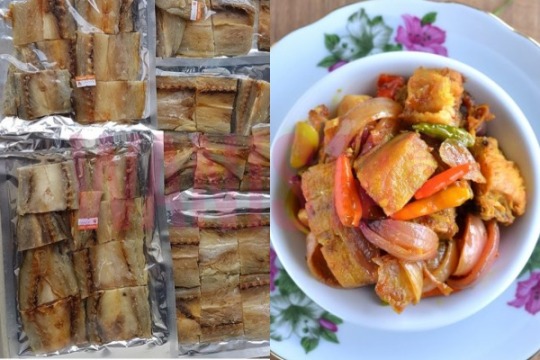
The one i used in my creamy and spicy banana curry that day is called: gelama (croaker)

Both pics are from Arkib Wanista
3 notes
·
View notes
Text
I like eating fish. Raw fish, specifically. My cooking isn't phenomenal unfortunately but fish is my favorite ingredient to eat. Especially the oily ones with a fishy taste like salmon and yellowtail and mackerel. Mackerel is great broiled or grilled but it gives off a really strong odor and oily residue that lingers around for millennias so you have to do it outside.
I like seafood in general and, excluding fish, my favorites (raw) are oysters and red clams. I like shellfish too. I do have a mild allergy but that doesn't stop me from eating a full platter of shrimp every once in a while even though I have to take antihistamine an hour beforehand and even then it still upsets my stomach. Crabs are really good but I feel like it's hard and expensive to get a hold of in the US? It's much cheaper in Vietnam but I guess that's what you get for being a fishing country. Oh you can't eat these raw (I forgot to specify) and I meant boiled or steamed shrimps and/or crabs (sometimes you do it together).
I'm not a big fan of lobster. When I do have lobster I don't want it to be cooked in a complicated dish. I want to taste the lobster meat like I do with crabs and shrimps. I think I like seafood because they all have such a nice taste even without any seasoning at all and I prefer simple dishes in general. I like spaghetti because when you take it apart it's really just pasta, sauce, and parmesan cheese (I like shaved pieces) which now comes full circle because I think that's why I like raw fish. It's fish and it's raw. With nothing on it. Maybe sushi rice. Possibly a little soy sauce and wasabi. Spices and such are nice but sometimes it muddles the taste. Idk. I would kill for a good stew but it will never beat a full sashimi platter (my yet-to-be-fulfilled endgame dream).
2 notes
·
View notes
Text
Asian - Japanese Broiled Mackerel

A Japanese marinade sauce gives a lovely taste and texture to broiled mackerel in this Japanese mackerel recipe. Yellow tail, tuna, or salmon are also good in this recipe. Easy and exotic!
0 notes
Photo

Recipe for Japanese Broiled Mackerel
A Japanese marinade sauce gives a lovely taste and texture to broiled mackerel in this Japanese mackerel recipe. Yellow tail, tuna, or salmon are also good in this recipe. Easy and exotic!
0 notes
Photo

Welcome to Triangle Hofbrau Restaurant, would you care for the menu? http://menus.nypl.org/menus/29856
#menubot#What's On The Menu?#NYPL#1947#Triangle Hofbrau Restaurant#Broiled King Mackerel - Lem. Butter#Spec.
0 notes
Photo
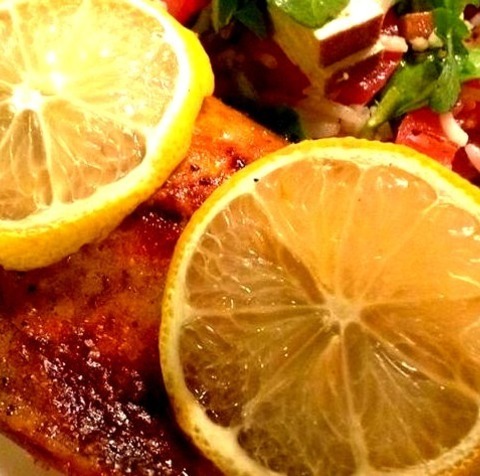
Broiled Spanish Mackerel Recipe
Fresh Spanish mackerel is seasoned in this straightforward broiler recipe with lemon slices, paprika, salt, and pepper.
0 notes
Text
numbness, and discomfort. Diabetes is the leading cause of neuropathy, accounting for up to 70% of all cases. While anti-inflammatory medicines and other treatments can be beneficial, did you know that the foods you eat can influence your neuropathy symptoms? Learn how dietary modifications can help reduce neuropathy pain and inflammation.
At DRC, we treat a wide range of diabetes-related neurological problems, led by our specialist Dr Soumya. Dr. Soumya may recommend dietary adjustments as part of your treatment strategy to assist alleviate your neuropathy symptoms. Here’s what you need to know.
Carbohydrates, blood sugar levels, and nerve function
Controlling your blood sugar levels is essential if you have diabetes. Chronically high blood sugar destroys nerves, preventing them from transmitting correct impulses. The basic technique for maintaining healthy blood sugar levels is to limit carbohydrate intake. This includes eating healthful carbohydrates such as whole grains, fruits, and non starchy vegetables and staying within the carbohydrate range prescribed by your doctor. This will keep your neuropathy from worsening and will help you avoid diabetic neuropathy problems like foot ulcers.
The lowdown on dietary fat
The kind and amount of fat in your diet can have an impact on nerve function. Elevated fat levels in the blood can damage sensitive nerve fibres and cause or aggravate neuropathy. The saturated fat present in animal meals has the greatest influence on boosting LDL, a dangerous type of cholesterol. Reduced saturated fat consumption can assist support nerve function and prevent neuropathy from worsening. Here are several examples:
Limit your intake of fast food.
Select low-fat dairy products.
Avoid eating processed meats.
Choose lean cuts of beef.
Instead of frying, bake and broil.
Reduce your use of animal products.
Choose unsaturated oils such as olive, sesame, and walnut.
Mercury, fish, and neuropathy
Fish provides vital fats that your body requires to function properly, and while it is advised that you eat at least two meals each week to get health advantages, if you have neuropathy, you must exercise caution. Certain fish contain high quantities of mercury, a toxin that, at excessive levels, can damage nerves and cause or aggravate neuropathy.
Larger fish collect more mercury than smaller fish because they live longer. Mercury levels are high in king mackerel, orange roughy, swordfish, tuna, and grouper. Choose low-mercury fish if you have neuropathy, such as:
Cod, salmon, catfish, pollock, haddock, and tilapia are all examples of fish.
Eliminating alcohol from the equation
Alcohol is poisonous to your nerves, and drinking too much of it can induce or worsen neuropathy. Aside from being physically hazardous to nerve tissue, alcohol lowers absorption of B vitamins and vitamin E, both of which are essential for neuron function. To best control your neuropathy, avoid alcohol completely.
Nutrition and nerve support
Adopting a nerve-supportive dietary pattern is one of the most important actions you can take to manage neuropathy. Vitamins B6, B12, folate, thiamin, and E are all required for normal nerve function. A varied diet rich in lean protein, fruits, vegetables, healthy fats, and whole grains is the best way to receive enough of these elements. If you have a deficiency, your provider may prescribe supplementing one or more of these vitamins in addition to your diet.
Managing neuropathy entails taking the necessary steps to halt its progression, reduce the risk of consequences, and relieve related symptoms. Having the appropriate care team might mean the difference between life and death. To schedule an appointment with Dr. Soumya for effective diabetic neuropathy care, call us or book your request online.
Related-
Know more about Ayurveda Diabetes Reversal.
0 notes
Text
Isn't attaining perfect shape tempting?
It is common knowledge that protein helps in gaining muscle, but do you know that it also aids in losing weight?
Are you wondering how protein contributes to weight loss? In this blog, we will learn how a protein known for contributing to muscle gain helps with weight loss.
Protein is essential for weight loss because it can help increase the feeling of fullness, boost metabolism, and preserve lean muscle mass.The best protein sources for weight loss are those that are low in calories and saturated fats while providing high-quality protein.
Some Common Protein Sources
Here are some protein sources that are commonly recommended for weight loss:
Lean meats: Skinless poultry, lean cuts of beef or pork, and game meats are excellent sources of protein. Grilling, baking, or broiling these meats is a healthier cooking option compared to frying.
Fish: Fatty fish like salmon, mackerel, and trout are rich in protein and healthy omega-3 fatty acids. These fats can help with satiety and provide other health benefits. Baking or grilling fish is a great way to prepare them.
Eggs: Eggs are a fantastic source of protein and contain essential vitamins and minerals.
Dairy: Low-fat or fat-free dairy products like Greek yogurt, cottage cheese, and skim milk are rich in protein. These options are lower in calories and saturated fats compared to their full-fat counterparts.
Meal Replacement Powder for Weight Loss
Meal replacement powder can be a convenient way to increase protein intake, especially for those who struggle to meet their protein needs through whole foods. Look for meal replacement powders with minimal added sugars and other additives. Check for allergens. Select a meal replacement powder that has a high protein-to-calorie ratio.
The most suitable meal replacement powder varies according to individual preferences and dietary requirements. Various types of supplements are accessible, and each offers its unique advantages.
Here are a few well-liked meal replacement powder protein choices that can be advantageous for weight loss:
Whey Protein:
Whey protein is a quickly digestible protein sourced from milk. It contains all the essential amino acids and is notably high in leucine, a key player in muscle protein synthesis. Scientific studies have demonstrated that meal replacement powder with whey protein can support weight loss efforts by enhancing feelings of fullness and preserving lean muscle mass. Maintaining muscle mass is important for sustaining a higher metabolic rate, which aids in weight management.
Casein Protein:
Casein protein, also derived from milk, differs from whey in its slow digestion rate. It provides a gradual and sustained release of amino acids, leading to prolonged feelings of fullness. This characteristic of meal replacement powder makes it a valuable option for controlling appetite and reducing overall calorie consumption during weight-loss endeavors.
Plant-based sources:
For vegetarians or vegans, there are plenty of plant-based meal replacement powder protein sources like tofu, tempeh, legumes (beans, lentils, chickpeas), and quinoa. These are generally lower in calories and saturated fat than many animal-based proteins.
Conclusion
When incorporating meal replacement powder protein into your diet for weight loss, it's important to consider portion control and overall calorie intake. A balanced diet that includes a variety of foods and regular physical activity is crucial for successful and sustainable weight loss.
Reference:- https://www.slim24pro.com/blog/best-protein-range-for-effective-weight-loss.html
#meal replacement shake#weight loss shakes#meal replacement powder#protein powder for weight loss#best weight loss supplement#weight loss supplements#meal replacements#weight loss shakes and supplements
1 note
·
View note
Photo
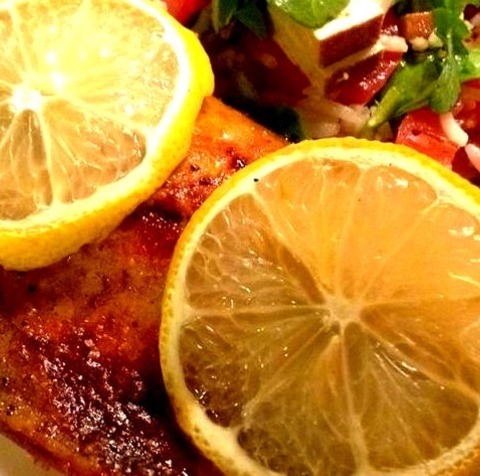
Broiled Spanish Mackerel
This simple recipe for fish cooked under the broiler uses lemon slices, paprika, salt, and pepper to season fresh Spanish mackerel. 1/4 cup olive oil, salt and ground black pepper to taste, 1/2 teaspoon paprika, 6 fillets Spanish mackerel fillets, 12 slices lemon
0 notes
Text
Jangeo-gui: Grilled Freshwater Eel, a Savory Korean Delicacy

Jangeo-gui (장어구이) is a popular Korean dish made with grilled freshwater eel. The dish is prized for its delicate and slightly sweet flavor, as well as its tender and juicy texture.
Jangeo-gui is typically prepared by marinating the eel in a mixture of soy sauce, garlic, ginger, and other seasonings, and then grilling it over an open flame. The resulting dish is a savory and succulent treat that is often enjoyed as a main course or as a side dish.
Jangeo-gui is a versatile dish that can be prepared in a variety of ways, such as pan-frying or broiling, and can be served with a variety of side dishes, such as rice, kimchi, or pickled vegetables. It is also a popular dish to enjoy with a cold beer or soju.
Through our experience using this product, we have found that Jangeo-gui is a delicious and easy-to-prepare dish that is perfect for any occasion. The combination of flavors and textures create a unique and satisfying dish that is sure to impress your guests.
FAQ:
Q: Where can I find freshwater eel for Jangeo-gui?
A: Freshwater eel can be found in most Asian markets or specialty seafood stores. You can also try ordering it online from a reputable seller.
Q: How do I clean and gut freshwater eel?
A: To clean and gut freshwater eel, rinse it under cold water and use a sharp knife to make a cut along the belly. Carefully remove the guts and rinse the eel again under cold water. Cut off the head and tail and discard them.
Q: Can I use other types of fish for Jangeo-gui?
A: While freshwater eel is the traditional fish used in Jangeo-gui, you can also use other types of fish that have a firm texture and can be grilled, such as mackerel or salmon.
Q: Can I cook Jangeo-gui in the oven or on the stovetop?
A: Yes, you can cook Jangeo-gui in the oven or on the stovetop. To cook in the oven, preheat the oven to 375°F (190°C) and bake the eel for 15-20 minutes, or until cooked through. To cook on the stovetop, heat a non-stick pan over medium-high heat and cook the eel for 5-7 minutes on each side, or until cooked through.
Q: Is freshwater eel healthy to eat?
A: Freshwater eel is a good source of protein, omega-3 fatty acids, and other nutrients. However, it is also high in cholesterol and should be consumed in moderation.
Q: How should I store leftover Jangeo-gui?
A: Store leftover Jangeo-gui in an airtight container in the refrigerator for up to 3 days. To reheat, place the eel on a baking sheet and bake in a preheated oven at 375°F (190°C) for 10-15 minutes, or until heated through.
Q: Can I freeze Jangeo-gui?
A: Yes, you can freeze Jangeo-gui for up to 2 months. Let the eel cool completely before transferring it to a freezer-safe container. Thaw the eel in the refrigerator overnight before reheating it in the oven or on the grill.
Conclusion:
After our findings, it is clear that Jangeo-gui is a flavorful and unique Korean dish that is enjoyed by many. This dish is made with freshwater eel, which is first marinated in a mixture of soy sauce, honey, rice wine, garlic, ginger, and sesame oil, then grilled until tender and slightly charred.
Through our experience, we found that the key to a delicious Jangeo-gui is to use fresh and high-quality eel, and to marinate it for at least an hour before grilling. The marinade adds a complex and savory flavor to the eel, while the grilling process imparts a smoky and slightly charred flavor that complements the sweetness of the marinade.
Jangeo-gui is a versatile dish that can be served as a main course or as a side dish, and pairs well with a variety of Korean side dishes such as rice, kimchi, and pickled vegetables. It is also a popular dish to enjoy with a cold beer or soju, making it a great option for parties and gatherings.
Overall, Jangeo-gui is a delicious and unique dish that is sure to impress your guests. With its delicate and savory flavor, this dish is a must-try for anyone looking to explore the diverse flavors of Korean cuisine.
Read the full article
0 notes
Text
Watch "전국 1위 된장찌개 맛집" on YouTube
Tasty Soybean Paste / Doenjang jjige Restaurant in Korea. I make well soybean paste soup too. My soybean paste soup is dried anchovy base and 1 cup anchovy base water for 1 soup spoon of soybean paste for one person and onion, potato, 1 green pepper or not, 2 clove galic and lot of dubu(tofu), beef, zucchini, at the end sprinkle chopped scallion and my family love my soybean paste soup. When I broiled Mackerel or sardines, I make soybean paste soup and roasted seaweed/ Gim-gui, it is like meat ball and pasta XD
0 notes